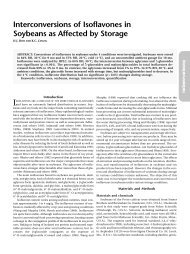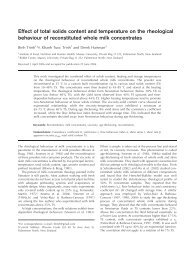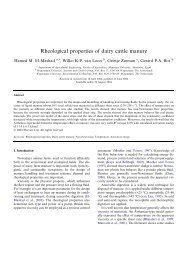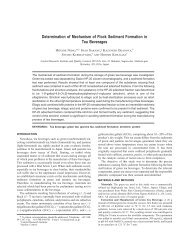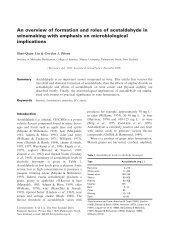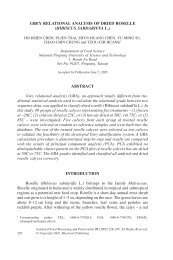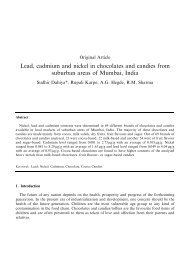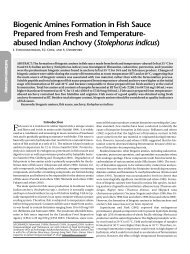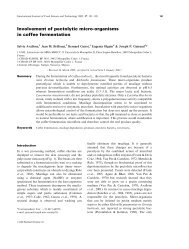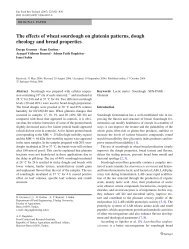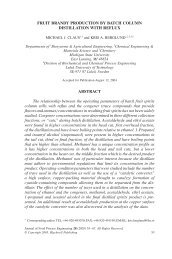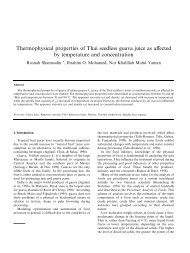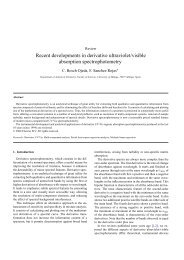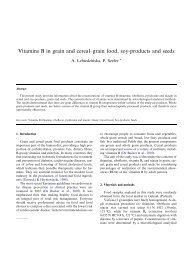Effect of Ozone on Postharvest Quality of Persimmon
Effect of Ozone on Postharvest Quality of Persimmon
Effect of Ozone on Postharvest Quality of Persimmon
Create successful ePaper yourself
Turn your PDF publications into a flip-book with our unique Google optimized e-Paper software.
<str<strong>on</strong>g>Effect</str<strong>on</strong>g> <str<strong>on</strong>g>of</str<strong>on</strong>g> <str<strong>on</strong>g>Oz<strong>on</strong>e</str<strong>on</strong>g> <strong>on</strong> <strong>Postharvest</strong><br />
<strong>Quality</strong> <str<strong>on</strong>g>of</str<strong>on</strong>g> Persimm<strong>on</strong><br />
ALEJANDRA SALVADOR, ISABEL ABAD, LUCíA ARNAL, AND J.M. MARTíNEZ-JÁVEGA<br />
ABSTRACT: The effect <str<strong>on</strong>g>of</str<strong>on</strong>g> gaseous oz<strong>on</strong>e exposure <strong>on</strong> the quality <str<strong>on</strong>g>of</str<strong>on</strong>g> persimm<strong>on</strong> picked at 2 different harvest dates<br />
was evaluated. Fruit from both harvests were c<strong>on</strong>tinuously exposed to 0.15 ppm (vol/vol) <str<strong>on</strong>g>of</str<strong>on</strong>g> oz<strong>on</strong>e for 30 d at 15 ◦ C,<br />
90% relative humidity (RH). Then, fruit were submitted to astringency removal treatment (24 h at 20 ◦ C, 98% CO2)<br />
and stored for 7 d at 20 ◦ C (90% RH) in order to simulate shelf-life period. The most important disorder was flesh<br />
s<str<strong>on</strong>g>of</str<strong>on</strong>g>tening, which took place when fruit were transferred from 15 ◦ C to shelf-life c<strong>on</strong>diti<strong>on</strong>s. In the 2nd harvest, where<br />
the fruit were harvested with lower firmness, oz<strong>on</strong>e maintained firmness over commercial limits even after 30 d at<br />
15 ◦ C plus shelf-life. <str<strong>on</strong>g>Oz<strong>on</strong>e</str<strong>on</strong>g>-treated fruit showed the highest values <str<strong>on</strong>g>of</str<strong>on</strong>g> weight loss, coinciding with the maximum<br />
electrolyte leakage (EL) percentage. <str<strong>on</strong>g>Oz<strong>on</strong>e</str<strong>on</strong>g> did not affect color index (CI), ethanol, total soluble solids (TSS), or pH.<br />
Unremarkable differences in acetaldehyde were observed between fruit submitted to oz<strong>on</strong>e treatment and c<strong>on</strong>trol<br />
fruit. No phytotoxic injuries in tissues were observed in oz<strong>on</strong>e-treated fruit.<br />
Keywords: firmness, harvest date, oz<strong>on</strong>e, persimm<strong>on</strong>, storage<br />
Introducti<strong>on</strong><br />
Persimm<strong>on</strong> crop has underg<strong>on</strong>e an important expansi<strong>on</strong> in the<br />
last years, becoming a good alternative to the other fruit crops in<br />
the Mediterranean area. In this way, from 1992 to 2003, persimm<strong>on</strong><br />
crop has increased close to 150%. The main reas<strong>on</strong> for this expansi<strong>on</strong><br />
is the new way to present “Rojo Brillante” cultivar, without astringency<br />
and with high firmness after being submitted to astringency<br />
removal treatment using high c<strong>on</strong>centrati<strong>on</strong> <str<strong>on</strong>g>of</str<strong>on</strong>g> CO2 (Arnal and Del<br />
Río 2003). This fact has allowed opening <str<strong>on</strong>g>of</str<strong>on</strong>g> new market perspectives,<br />
<str<strong>on</strong>g>of</str<strong>on</strong>g>fering advantages over standard traditi<strong>on</strong>al persimm<strong>on</strong>, s<str<strong>on</strong>g>of</str<strong>on</strong>g>t fruit<br />
with very difficult postharvest manipulati<strong>on</strong>.<br />
A point to note is that persimm<strong>on</strong> producti<strong>on</strong> in this area is centralized<br />
in this cultivar, whose harvest period is short, from October<br />
to December. This is because <strong>on</strong>e <str<strong>on</strong>g>of</str<strong>on</strong>g> the main goals is to prol<strong>on</strong>g<br />
postharvest life. Fruits <str<strong>on</strong>g>of</str<strong>on</strong>g> cultivar “Rojo Brillante” are sensitive to<br />
low temperatures and show a drastic s<str<strong>on</strong>g>of</str<strong>on</strong>g>tening as the manifestati<strong>on</strong><br />
<str<strong>on</strong>g>of</str<strong>on</strong>g> chilling injury. As c<strong>on</strong>sequence, fruit storage is carried out close to<br />
15 ◦C, nevertheless this temperature is too high to prol<strong>on</strong>g storage<br />
(Arnal and Del Río 2004; Salvador and others 2005). On the other<br />
hand, although persimm<strong>on</strong> has not high susceptibility to pathogen<br />
c<strong>on</strong>taminati<strong>on</strong>, this storage temperature does not help to fungal<br />
c<strong>on</strong>trol.<br />
The effect <str<strong>on</strong>g>of</str<strong>on</strong>g> oz<strong>on</strong>e exposure <strong>on</strong> fungal decay during postharvest<br />
storage has been studied for different commodities with some discrepancies<br />
in the results. <str<strong>on</strong>g>Oz<strong>on</strong>e</str<strong>on</strong>g> does not seem to c<strong>on</strong>trol pathogen<br />
in wounds, and cannot be substituted for the synthetic fungicides<br />
that are currently applied in packing-lines; nevertheless exposure<br />
to gaseous oz<strong>on</strong>e inhibits the aerial growth <str<strong>on</strong>g>of</str<strong>on</strong>g> the mycelia and prevents<br />
sporulati<strong>on</strong> <str<strong>on</strong>g>of</str<strong>on</strong>g> the important postharvest pathogens in different<br />
commodities (Palou and others 2001, 2002, 2003).<br />
The benefits <str<strong>on</strong>g>of</str<strong>on</strong>g> oz<strong>on</strong>e depend <strong>on</strong> different factors, such as envir<strong>on</strong>mental<br />
c<strong>on</strong>diti<strong>on</strong>s, temperature, and humidity (Palou and others<br />
MS 20060019 Submitted 1/11/2006, Accepted 4/24/2006. The authors are with<br />
Centro de Tecnología de Postcosecha, Inst. Valenciano de Investigaci<strong>on</strong>es<br />
Agrarias, 46113 Valencia, Spain. Direct inquiries to author Salvador (E-mail:<br />
asalvado@ivia.es).<br />
Further reproducti<strong>on</strong> without permissi<strong>on</strong> is prohibited<br />
2001). Due to the lack <str<strong>on</strong>g>of</str<strong>on</strong>g> oz<strong>on</strong>e penetrati<strong>on</strong>, the efficacy <str<strong>on</strong>g>of</str<strong>on</strong>g> this treatment<br />
also depends <strong>on</strong> the type <str<strong>on</strong>g>of</str<strong>on</strong>g> package; therefore, no benefits<br />
were found for oz<strong>on</strong>e gas exposure when citrus fruit were packed<br />
in corrugated fiberboard cart<strong>on</strong>s or plastic bags (Palou and others<br />
2003). On the other hand, the ability <str<strong>on</strong>g>of</str<strong>on</strong>g> gaseous oz<strong>on</strong>e to react<br />
with ethylene leads to this treatment as potential tool to be used<br />
in rooms where sensitive ethylene commodities were stored (Dicks<strong>on</strong><br />
and others 1992; Skog and Chu 2001). In this sense, persimm<strong>on</strong><br />
fruit normally produce small amounts <str<strong>on</strong>g>of</str<strong>on</strong>g> ethylene; however, it is<br />
known that marked increases in the endogenous levels <str<strong>on</strong>g>of</str<strong>on</strong>g> ethylene<br />
are produced by different c<strong>on</strong>diti<strong>on</strong>s, such as wounds or pathogen<br />
presence. Additi<strong>on</strong>ally, persimm<strong>on</strong> fruit is very sensitive to ethylene<br />
acti<strong>on</strong>, and exposure to low c<strong>on</strong>centrati<strong>on</strong>s <str<strong>on</strong>g>of</str<strong>on</strong>g> ethylene accelerates<br />
s<str<strong>on</strong>g>of</str<strong>on</strong>g>tening (Nakano and others 2003).<br />
<str<strong>on</strong>g>Oz<strong>on</strong>e</str<strong>on</strong>g> treatment may also affect quality parameters. Skog and<br />
Chu (2001) reported that oz<strong>on</strong>e (0.4 μLL- 1 ) improved the quality <str<strong>on</strong>g>of</str<strong>on</strong>g><br />
broccoli and cucumber stored at 3 ◦ C, prol<strong>on</strong>ging the storage life.<br />
Nevertheless, no effects <str<strong>on</strong>g>of</str<strong>on</strong>g> oz<strong>on</strong>e treatment were found <strong>on</strong> quality<br />
parameters <strong>on</strong> cucumbers stored at 10 ◦ C, mushrooms stored<br />
at 4 ◦ C, or apples and pears kept at 1 ◦ C. In strawberry, oz<strong>on</strong>e induced<br />
delay <str<strong>on</strong>g>of</str<strong>on</strong>g> fruit s<str<strong>on</strong>g>of</str<strong>on</strong>g>tening and weight loss; however it increased<br />
a loss <str<strong>on</strong>g>of</str<strong>on</strong>g> fruit aroma (Perez and others 1999; Nadas and others 2003).<br />
<str<strong>on</strong>g>Oz<strong>on</strong>e</str<strong>on</strong>g> storage also resulted in market quality extensi<strong>on</strong> <str<strong>on</strong>g>of</str<strong>on</strong>g> blackberries<br />
(Barth and others 1995). Treatments with oz<strong>on</strong>ated water<br />
also have been effective in reducing microbial populati<strong>on</strong> and in<br />
improving the storage quality <strong>on</strong> fresh-cut celery, cilantro, and lettuce<br />
(García and others 2003; Wang and others 2004; Zhang and<br />
others 2005). However, immersi<strong>on</strong> in oz<strong>on</strong>ated water did not c<strong>on</strong>trol<br />
postharvest decay <str<strong>on</strong>g>of</str<strong>on</strong>g> citrus fruit, peaches and nectarines, and<br />
table grapes (Smilanick and others 2002).<br />
The effects <str<strong>on</strong>g>of</str<strong>on</strong>g> oz<strong>on</strong>e exposure <strong>on</strong> fruit and vegetable quality seem<br />
to be highly dependent <strong>on</strong> the commodities, and therefore must be<br />
individually assessed for each commodity at its ideal storage temperature<br />
(Liew and Prange 1994).<br />
Storage under atmosphere c<strong>on</strong>taining oz<strong>on</strong>e is being c<strong>on</strong>sidered<br />
an alternative to maintain persimm<strong>on</strong> at 15 ◦ C, but there is no clear<br />
informati<strong>on</strong> about the effects <strong>on</strong> quality parameters. In this study,<br />
S: Sensory & Nutritive Qualities <str<strong>on</strong>g>of</str<strong>on</strong>g> Food
S: Sensory & Nutritive Qualities <str<strong>on</strong>g>of</str<strong>on</strong>g> Food<br />
<str<strong>on</strong>g>Oz<strong>on</strong>e</str<strong>on</strong>g> effect <strong>on</strong> persimm<strong>on</strong> . . .<br />
the effect <str<strong>on</strong>g>of</str<strong>on</strong>g> oz<strong>on</strong>e treatment <strong>on</strong> the quality <str<strong>on</strong>g>of</str<strong>on</strong>g> persimm<strong>on</strong> picked at<br />
2 different harvest dates, during storage at 15 ◦ C, was evaluated.<br />
Materials and Methods<br />
Plant material and treatments<br />
“Rojo Brillante” persimm<strong>on</strong>s (Diospyros kaki L.) were obtained<br />
from L’Alcudia (Valencia, Spain) at 2 harvest dates, <strong>on</strong> October 27<br />
(Harvest 1) and <strong>on</strong> November 24 (Harvest 2). Fruit were transported<br />
immediately to the Inst. Valenciano de Investigaci<strong>on</strong>es Agrarias<br />
(IVIA) experimental stati<strong>on</strong>, where they were carefully selected for<br />
uniformity <str<strong>on</strong>g>of</str<strong>on</strong>g> size and color development and randomly separated<br />
into 2 groups by pers<strong>on</strong>nel familiar with this persimm<strong>on</strong> cultivar.<br />
Both groups were stored in chambers <str<strong>on</strong>g>of</str<strong>on</strong>g> 1.5 m 3 for up to 30 d at<br />
15 ◦ C, 90% RH, <strong>on</strong>e in air (c<strong>on</strong>trol) and the other in air enriched<br />
with 0.15 ppm <str<strong>on</strong>g>of</str<strong>on</strong>g> oz<strong>on</strong>e. An oz<strong>on</strong>e generator (mod XES-030, Grupo<br />
Interoz<strong>on</strong>e, Santiago, Chile) was used to achieve the desired c<strong>on</strong>centrati<strong>on</strong>.<br />
After 10, 20, and 30 d at 15 ◦ C, fruit were submitted to<br />
astringency removal treatment (24 h at 20 ◦ C, 98% CO2) (Salvador<br />
and others 2004) and then held for 7 d at 20 ◦ C, 90% RH to simulate<br />
shelf-life. Astringency removal was carried out in closed c<strong>on</strong>tainers,<br />
and the desired atmosphere was established by passing a stream <str<strong>on</strong>g>of</str<strong>on</strong>g><br />
air c<strong>on</strong>taining 98% CO2 through the c<strong>on</strong>tainers.<br />
<str<strong>on</strong>g>Oz<strong>on</strong>e</str<strong>on</strong>g> c<strong>on</strong>centrati<strong>on</strong> was c<strong>on</strong>tinuously m<strong>on</strong>itored by UV absorpti<strong>on</strong><br />
oz<strong>on</strong>e analyzer (Model IN-2000-1, INUSA Inc., Needham, Mass.,<br />
U.S.A.) with a minimum detecti<strong>on</strong> limit <str<strong>on</strong>g>of</str<strong>on</strong>g> 0.01 ppm. Air from the<br />
oz<strong>on</strong>ated chamber was pumped through a Tefl<strong>on</strong> tube to the analyzer,<br />
which was located in an adjacent room. <str<strong>on</strong>g>Oz<strong>on</strong>e</str<strong>on</strong>g> level was also<br />
periodically measured using an oz<strong>on</strong>e detector tube (0.05 to 0.7 ppm,<br />
nr 6733181, Dräger Accuro, Canada Ltd., Mississauga, Ont., Canada)<br />
Fruit quality assessment<br />
Flesh firmness was determined over 20 fruit per treatment with a<br />
Texturometer Instr<strong>on</strong> Universal Machine model 4301 (Instr<strong>on</strong> Corp.,<br />
Cant<strong>on</strong>, Mass., U.S.A.), using an 8-mm plunger. Results were expressed<br />
as load in Newt<strong>on</strong>s (N) to break the flesh in each fruit <strong>on</strong><br />
opposite sides after peel removal.<br />
Weight loss was measured <strong>on</strong> 20 fruit per treatment, with the results<br />
expressed as a percentage. Electrolyte leakage (EL) was determined<br />
in triplicate for each sample. Six-mm dia pericarp discs were<br />
excised from the equatorial regi<strong>on</strong> <str<strong>on</strong>g>of</str<strong>on</strong>g> the fruit. Three lots <str<strong>on</strong>g>of</str<strong>on</strong>g> discs,<br />
approximately 2 g, were rinsed 3 times in distilled water, placed<br />
in 100 mL <str<strong>on</strong>g>of</str<strong>on</strong>g> 0.4 M mannitol soluti<strong>on</strong>, and incubated for 3 h at<br />
room temperature in c<strong>on</strong>tinuous shaking. The electrical c<strong>on</strong>ductivity<br />
readings <str<strong>on</strong>g>of</str<strong>on</strong>g> the soluti<strong>on</strong> were taken at 30-min intervals as a<br />
measure <str<strong>on</strong>g>of</str<strong>on</strong>g> EL from the discs, using a c<strong>on</strong>ductance meter (model<br />
C<strong>on</strong>sort C231, Electrochemical Multimeter, Belgium). After 3 h, the<br />
flasks were autoclaved for 30 min at 121 ◦ C and cooled, and a final<br />
c<strong>on</strong>ductivity reading was taken for total electrolytes. EL was expressed<br />
as a percentage <str<strong>on</strong>g>of</str<strong>on</strong>g> the total electrolytes.<br />
Skin color was evaluated by a Minolta Colorimeter (model CR-<br />
300, Minolta Co. Ltd., Osaka, Japan) <strong>on</strong> samples <str<strong>on</strong>g>of</str<strong>on</strong>g> 20 fruit per treatment.<br />
L, a, and b Hunter parameters were measured and results were<br />
expressed as skin color index (CI) (Jiménez-Cuesta and others 1981).<br />
Color index = (1000a)/(Lb)<br />
Three samples <str<strong>on</strong>g>of</str<strong>on</strong>g> juice sample from 15 different fruit per treatment<br />
were used to analyze total soluble solids (TSS), ethanol, and acetaldehyde<br />
c<strong>on</strong>centrati<strong>on</strong>s. TSS were measured with a digital refractometer<br />
(model PR-1, Atago, Japan) and expressed as ◦ Brix. To<br />
measure ethanol and acetaldehyde c<strong>on</strong>centrati<strong>on</strong>s, 5 mL <str<strong>on</strong>g>of</str<strong>on</strong>g> the filtered<br />
juice were transferred to 10 mL vials with crimp-top caps and<br />
a TFE/silic<strong>on</strong>e septa seal and frozen (−20 ◦ C) until analysis. Thereafter,<br />
samples were put in a water bath at 20 ◦ C for 1 h and then<br />
heated at 60 ◦ C for 10 min in a water bath. One milliliter <str<strong>on</strong>g>of</str<strong>on</strong>g> the<br />
headspace gas was withdrawn from the vials and injected into a gas<br />
chromatograph Perkin-Elmer (model 1020, Perkin Elmer Corp., Norwalk,<br />
C<strong>on</strong>n., U.S.A.), provided with a flame i<strong>on</strong>izati<strong>on</strong> detector (FID)<br />
and a 1/8 ′ × 1.2 m Poropak QS 80/100 column. The injector was set<br />
at 175 ◦ C, the column at 150 ◦ C, the detector (FID) at 200 ◦ C, and the<br />
carrier gas at 12.3 psi. Acetaldehyde and ethanol were identified by<br />
comparis<strong>on</strong> <str<strong>on</strong>g>of</str<strong>on</strong>g> retenti<strong>on</strong> times with standards and were expressed<br />
as mg/100 mL.<br />
Data were subjected to analysis <str<strong>on</strong>g>of</str<strong>on</strong>g> variance (ANOVA), and least<br />
significant difference (LSD) at the 5% level was used for comparing<br />
means using the Statgraphics plus 2.1 (Manugistics, Inc., Rockville,<br />
Md., U.S.A.).<br />
Results and Discussi<strong>on</strong><br />
Firmness is c<strong>on</strong>sidered <strong>on</strong>e <str<strong>on</strong>g>of</str<strong>on</strong>g> the most important quality parameters<br />
in persimm<strong>on</strong> fruit when it is commercialized after<br />
astringency removal. From previous experiments in this cultivar,<br />
firmness values lower than 10 N force have been c<strong>on</strong>sidered as not<br />
acceptable from a commercial point <str<strong>on</strong>g>of</str<strong>on</strong>g> view (Salvador and others<br />
2004).<br />
In the present study, in both harvest dates, a gradual decrease <str<strong>on</strong>g>of</str<strong>on</strong>g><br />
firmness fruit was observed throughout storage at 15 ◦ C (Figure 1),<br />
this s<str<strong>on</strong>g>of</str<strong>on</strong>g>tening being more marked after deastringency treatment<br />
plus shelf-life. In Harvest 1, firmness loss was similar in c<strong>on</strong>trol fruit<br />
than in oz<strong>on</strong>e-treated fruit throughout the whole experiment. In<br />
Harvest 2, fruit were harvested with lower firmness and differences<br />
between treatments were not observed during storage at 15 ◦ C; nevertheless<br />
after shelf-life c<strong>on</strong>diti<strong>on</strong>s, n<strong>on</strong>treated fruit underwent a<br />
more important s<str<strong>on</strong>g>of</str<strong>on</strong>g>tening than oz<strong>on</strong>ated fruit. In this way, after<br />
10 d at 15 ◦ C plus shelf-life, c<strong>on</strong>trol fruit presented n<strong>on</strong>commercial<br />
Firmness (N)<br />
Firmness (N)<br />
60<br />
50<br />
40<br />
30<br />
20<br />
10<br />
0<br />
60<br />
50<br />
40<br />
30<br />
20<br />
10<br />
0<br />
c<br />
c<br />
c<br />
bc<br />
b<br />
b<br />
b<br />
b<br />
a<br />
a<br />
C<strong>on</strong>trol <str<strong>on</strong>g>Oz<strong>on</strong>e</str<strong>on</strong>g><br />
a<br />
10 d 20 d 30 d 10d 20d 30d<br />
days at 15∫C 15°C days at 15∫C+5 15°C+5 d. at 20∫C 20°C<br />
a<br />
10 d 20 d 30 d 10d 20d 30d<br />
c<br />
a<br />
days at 15∫C 15°C days at 15∫C+5 15°C+5 d. at 20∫C 20°C<br />
c<br />
b<br />
b<br />
a<br />
b<br />
b<br />
a<br />
a<br />
H1<br />
a<br />
H2<br />
Figure 1 --- <str<strong>on</strong>g>Effect</str<strong>on</strong>g> <str<strong>on</strong>g>of</str<strong>on</strong>g> oz<strong>on</strong>e treatment <strong>on</strong> firmness during<br />
storage at 15 ◦ C and after subsequent shelf-life period at<br />
20 ◦ C (90% RH) <str<strong>on</strong>g>of</str<strong>on</strong>g> “Rojo Brillante” persimm<strong>on</strong> harvested<br />
at 2 different dates: Harvest 1 (H1) and Harvest 2 (H2).<br />
Fruit were submitted to astringency removal treatment<br />
prior to transfer to 20 ◦ C. Means for storage at 15 ◦ C or for<br />
shelf-life periods with the same letter are not significantly<br />
different at 5% level (LSD test).<br />
b
<str<strong>on</strong>g>Oz<strong>on</strong>e</str<strong>on</strong>g> effect <strong>on</strong> persimm<strong>on</strong> . . .<br />
values; meanwhile treated fruit showed values slightly superior to<br />
the commercial limit even after 30 d plus shelf-life.<br />
In previous studies, higher firmness was found in citrus and cucumbers<br />
treated with oz<strong>on</strong>e compared with c<strong>on</strong>trol (Nadas and others<br />
2000; Skog and Chu 2001). <str<strong>on</strong>g>Oz<strong>on</strong>e</str<strong>on</strong>g> also induced a delay <str<strong>on</strong>g>of</str<strong>on</strong>g> fruit<br />
s<str<strong>on</strong>g>of</str<strong>on</strong>g>tening in strawberry during cold storage and storage at room<br />
temperature (Nadas and others 2003).<br />
Weight loss is not usually a limiting factor in persimm<strong>on</strong> postharvest<br />
life due to their skin, which avoids water losses. In both studied<br />
harvests, similar weight losses were shown (Table 1), finding<br />
the most important values after simulating shelf-life. <str<strong>on</strong>g>Oz<strong>on</strong>e</str<strong>on</strong>g>-treated<br />
fruit showed the highest weight loss, achieving values <str<strong>on</strong>g>of</str<strong>on</strong>g> 3.6% after<br />
30 d <str<strong>on</strong>g>of</str<strong>on</strong>g> storage plus shelf-life.<br />
Crisosto and Palou (pers<strong>on</strong>al communicati<strong>on</strong>) also observed<br />
higher weight loss in peaches treated with oz<strong>on</strong>e than in n<strong>on</strong>treated<br />
<strong>on</strong>es; the highest water loss showed by the treated fruit was related<br />
to cuticle damage caused by oz<strong>on</strong>e.<br />
In our research, EL was measured in assessment carried out with<br />
early harvested fruit (Figure 2). The highest EL showed in oz<strong>on</strong>etreated<br />
fruit coincided with the highest weight loss observed in this<br />
fruit. According to Rao and others (2000), it seems that oz<strong>on</strong>e can react<br />
with cuticular comp<strong>on</strong>ents and with lipids and proteins in plants,<br />
as result suggests that membrane lipids are susceptible to oz<strong>on</strong>e<br />
damage. In cucumber, although oz<strong>on</strong>e treatment showed positive<br />
effects during storage, the oz<strong>on</strong>e samples appeared more desiccated<br />
than the c<strong>on</strong>trol (Skog and Chu 2001). With oz<strong>on</strong>e residual c<strong>on</strong>centrati<strong>on</strong><br />
<str<strong>on</strong>g>of</str<strong>on</strong>g> 10 to 22 μL L-1 at 2 ◦ C, Liew and Prange (1994) observed<br />
Table 1 --- <str<strong>on</strong>g>Effect</str<strong>on</strong>g> <str<strong>on</strong>g>of</str<strong>on</strong>g> oz<strong>on</strong>e treatment <strong>on</strong> weight loss during<br />
storage at 15 ◦ C and after subsequent shelf-life period<br />
at 20 ◦ C (90% RH) <str<strong>on</strong>g>of</str<strong>on</strong>g> “Rojo Brillante” persimm<strong>on</strong> harvested<br />
at 2 different dates: Harvest 1 and Harvest 2. Fruit<br />
were submitted to astringency removal treatment prior to<br />
transferring fruit to 20 ◦ C.<br />
Weight loss (%)<br />
Days at 15 ◦C Daysat15◦C + 5dat20◦C 10 20 30 10 20 30<br />
Harvest 1<br />
C<strong>on</strong>trol 0.4a 0.6b 0.8c 2.3b 1.8a 1.9a <str<strong>on</strong>g>Oz<strong>on</strong>e</str<strong>on</strong>g> 1.4d 1.7e 2.4f 3.5d 2.9c 3.6d Harvest 2<br />
C<strong>on</strong>trol 0.2a 0.3a 0.5b 0.2a 1.3b 2.0c <str<strong>on</strong>g>Oz<strong>on</strong>e</str<strong>on</strong>g> 0.9c 1.6d 2.1f 1.4b 2.8d 3.5e a–f Data followed by the same letter for storage at 15 ◦ C or for shelf-life periods<br />
did not differ at 5% significance level.<br />
Electrolyte leakage (%)<br />
40<br />
35<br />
30<br />
25<br />
20<br />
15<br />
10<br />
Harvest 1 C<strong>on</strong>trol <str<strong>on</strong>g>Oz<strong>on</strong>e</str<strong>on</strong>g><br />
5<br />
20 days at 15°C + 5 d. at 20°C<br />
0<br />
0 30 60 90 120 150 180<br />
Electrolyte leakage (%)<br />
40<br />
35<br />
30<br />
25<br />
20<br />
15<br />
10<br />
5<br />
0<br />
30 days at 15°C + 5 d. at 20°C<br />
0 30 60 90 120 150 180<br />
Incubati<strong>on</strong> Time (minutes) Incubati<strong>on</strong> Time (minutes)<br />
symptoms <str<strong>on</strong>g>of</str<strong>on</strong>g> physiological disrupti<strong>on</strong>s, such as respirati<strong>on</strong> rate, EL,<br />
and color changes. In other study, browning observed in the cut surface<br />
in broccoli stored with oz<strong>on</strong>e (1.7 μL L- 1 ), to also related to an<br />
increase <str<strong>on</strong>g>of</str<strong>on</strong>g> membrane permeability and a loss <str<strong>on</strong>g>of</str<strong>on</strong>g> cellular compartimentati<strong>on</strong><br />
(Skog and Chu 2001).<br />
In c<strong>on</strong>trast to our results, in strawberry, a reducti<strong>on</strong> <str<strong>on</strong>g>of</str<strong>on</strong>g> weight<br />
loss was observed with oz<strong>on</strong>e treatment that was related to a better<br />
maintenance <str<strong>on</strong>g>of</str<strong>on</strong>g> fruit firmness (Nadas and others 2003), and in<br />
carrots, oz<strong>on</strong>e did not affect weight loss (Liew and Prange 1994).<br />
Fruit from Harvest 1, with a very low external colorati<strong>on</strong>, gradually<br />
increased the CI during storage at 15 ◦ C, and this increase was<br />
more accentuated after astringency removal treatment and subsequent<br />
shelf-life (Figure 3). In Harvest 2, the initial CI was higher<br />
and slight increases in colorati<strong>on</strong> occurred during storage at 15 ◦ C<br />
until achieving the maximum CI values, close to 30, without significant<br />
increment after transferring the fruit at shelf-life c<strong>on</strong>diti<strong>on</strong>s.<br />
No differences were observed between oz<strong>on</strong>e-treated fruit and n<strong>on</strong>treated<br />
fruit in both harvests. In other commodities, color changes<br />
have been affected by the oz<strong>on</strong>e treatment. Nadas and others (2000)<br />
observed that treatment with oz<strong>on</strong>e delayed color evoluti<strong>on</strong> in citrus<br />
fruit. <str<strong>on</strong>g>Oz<strong>on</strong>e</str<strong>on</strong>g> also affected the carrot color (Liew and Prange 1994).<br />
Acetaldehyde producti<strong>on</strong> was very low at both harvests and slight<br />
changes were shown during storage at 15 ◦ C (Table 2). After astringency<br />
removal treatment plus 5 d at 20 ◦ C, this volatile increased due<br />
to anaerobic c<strong>on</strong>diti<strong>on</strong>s induced by CO2 treatment (Arnal and Del<br />
Río 2003). Unremarkable differences were observed between fruit<br />
submitted to oz<strong>on</strong>e atmosphere and c<strong>on</strong>trol fruit. <str<strong>on</strong>g>Oz<strong>on</strong>e</str<strong>on</strong>g> had no effect<br />
<strong>on</strong> ethanol producti<strong>on</strong> throughout the assay (data not shown).<br />
At harvest, fruit from H1 presented lower TSS values than fruit<br />
from H2, and no changes were observed throughout storage at 15 ◦ C<br />
in any case (Table 3). After shelf-life c<strong>on</strong>diti<strong>on</strong>s, fruit exhibited a significant<br />
decrease with respect to the values presented just after storage<br />
at 15 ◦ C. This decrease observed after astringency removal treatment<br />
and subsequent shelf-life was due to the reducti<strong>on</strong> <str<strong>on</strong>g>of</str<strong>on</strong>g> soluble<br />
tannins resp<strong>on</strong>sible for fruit astringency, because they are included<br />
in TSS measurements and they are reduced with astringency removal<br />
treatment (Arnal and Del Río 2003). <str<strong>on</strong>g>Oz<strong>on</strong>e</str<strong>on</strong>g> treatment did not<br />
affect this parameter in both harvests. Changes in the values <str<strong>on</strong>g>of</str<strong>on</strong>g> pH<br />
were not observed during storage at 15 ◦ C and subsequent shelf-life<br />
period, maintaining similar values than initial in the 2 experiments<br />
(data not shown). <str<strong>on</strong>g>Oz<strong>on</strong>e</str<strong>on</strong>g> has no effect <strong>on</strong> this parameter.<br />
Perez and others (1999) reported that sugar and organic acids<br />
c<strong>on</strong>centrati<strong>on</strong>s in strawberry were lower in oz<strong>on</strong>e treatments than<br />
in c<strong>on</strong>trol samples; however, these differences were not observed<br />
Figure 2 --- <str<strong>on</strong>g>Effect</str<strong>on</strong>g> <str<strong>on</strong>g>of</str<strong>on</strong>g> oz<strong>on</strong>e<br />
treatment <strong>on</strong> electrolyte<br />
leakage (%) during storage<br />
at 15 ◦ C and after<br />
subsequent shelf-life period<br />
at 20 ◦ C (90% RH) <str<strong>on</strong>g>of</str<strong>on</strong>g> “Rojo<br />
Brillante” persimm<strong>on</strong>. Fruit<br />
were submitted to<br />
astringency removal<br />
treatment prior to transfer<br />
to 20 ◦ C.<br />
S: Sensory & Nutritive Qualities <str<strong>on</strong>g>of</str<strong>on</strong>g> Food
S: Sensory & Nutritive Qualities <str<strong>on</strong>g>of</str<strong>on</strong>g> Food<br />
<str<strong>on</strong>g>Oz<strong>on</strong>e</str<strong>on</strong>g> effect <strong>on</strong> persimm<strong>on</strong> . . .<br />
H1<br />
CI (1000a/Lb)<br />
H2<br />
CI (1000a/Lb)<br />
35<br />
30<br />
25<br />
20<br />
15<br />
10<br />
5<br />
0<br />
35<br />
30<br />
25<br />
20<br />
15<br />
10<br />
5<br />
0<br />
a<br />
a<br />
ab<br />
a<br />
b<br />
ab<br />
b<br />
bc<br />
c<br />
c<br />
C<strong>on</strong>trol <str<strong>on</strong>g>Oz<strong>on</strong>e</str<strong>on</strong>g><br />
c<br />
10 d 20 d 30 d 10d 20d 30d<br />
c<br />
ab<br />
abc<br />
ab<br />
ab<br />
bc<br />
10 d 20 d 30 d 10d 20d 30d<br />
a<br />
days at 15∫ 15°C C days at 15∫ 15°C+5 C+5 d. at 20∫ 20°C C<br />
days at 15∫ 15°C C days at 15∫ 15°C+5 C+5 d. at 20∫ 20°C C<br />
Figure 3 --- <str<strong>on</strong>g>Effect</str<strong>on</strong>g> <str<strong>on</strong>g>of</str<strong>on</strong>g> oz<strong>on</strong>e treatment <strong>on</strong> external color (CI)<br />
during storage at 15 ◦ C and after subsequent shelf-life period<br />
at 20 ◦ C (90% RH) <str<strong>on</strong>g>of</str<strong>on</strong>g> “Rojo Brillante” persimm<strong>on</strong> harvested<br />
at 2 different dates: Harvest 1 (H1) and Harvest 2<br />
(H2). Fruit were submitted to astringency removal treatment<br />
prior to transfer to 20 ◦ C. Means for storage at 15<br />
◦ C or for shelf-life periods with the same letter are not<br />
significantly different at 5% level (LSD test).<br />
Table 2 --- <str<strong>on</strong>g>Effect</str<strong>on</strong>g> <str<strong>on</strong>g>of</str<strong>on</strong>g> oz<strong>on</strong>e treatment <strong>on</strong> acetaldehyde producti<strong>on</strong><br />
(mg/100 mL) during storage at 15 ◦ C and after<br />
subsequent shelf-life period at 20 ◦ C (90% RH) <str<strong>on</strong>g>of</str<strong>on</strong>g> “Rojo<br />
Brillante” persimm<strong>on</strong> harvested at 2 different dates: Harvest<br />
1 and Harvest 2. Fruit were submitted to astringency<br />
removal treatment prior to transfer fruit to 20 ◦ C.<br />
a<br />
Acetaldehyde (mg/100 mL)<br />
Days at 15 ◦C Daysat15◦C + 5dat20◦C 10 20 30 10 20 30<br />
Harvest 1<br />
C<strong>on</strong>trol 0.17b 0.21c 0.13a 3.89e 2.96b,c 1.97a <str<strong>on</strong>g>Oz<strong>on</strong>e</str<strong>on</strong>g> 0.12a 0.16b 0.16b 3.44c,d 3.13c 2.57b Harvest 2<br />
C<strong>on</strong>trol 0.21c 0.20b,c 0.14a 3.30c 2.46a 3.48c <str<strong>on</strong>g>Oz<strong>on</strong>e</str<strong>on</strong>g> 0.24d 0.18b 0.15a 2.80b 2.76a,b 3.48c a–e Data followed by the same letter for storage at 15 ◦ C or for shelf-life periods<br />
did not differ at 5% significance level.<br />
by Nadas and others (2003). <str<strong>on</strong>g>Oz<strong>on</strong>e</str<strong>on</strong>g> treatment affects neither TSS<br />
in pear and apple nor titratable acidity in apple during prol<strong>on</strong>ged<br />
storage (Skog and Chu 2001).<br />
In the present research, any visual damage in c<strong>on</strong>trol or oz<strong>on</strong>etreated<br />
fruit was found under assayed c<strong>on</strong>diti<strong>on</strong>s.<br />
C<strong>on</strong>clusi<strong>on</strong><br />
<str<strong>on</strong>g>Oz<strong>on</strong>e</str<strong>on</strong>g> treatment had a positive effect <strong>on</strong> fruit firmness, this effect<br />
being dependent <strong>on</strong> harvest date; in fruit from 2nd harvest,<br />
oz<strong>on</strong>e maintained fruit with commercial firmness values up to 30 d<br />
plus shelf-life. <str<strong>on</strong>g>Oz<strong>on</strong>e</str<strong>on</strong>g> increased weight losses in treated fruits; this<br />
fact could be explained by an increase in EL. <str<strong>on</strong>g>Oz<strong>on</strong>e</str<strong>on</strong>g> had no important<br />
effects <strong>on</strong> other studied parameters. Therefore, oz<strong>on</strong>e could be<br />
c<strong>on</strong>sidered a tool to maintain quality <str<strong>on</strong>g>of</str<strong>on</strong>g> persimm<strong>on</strong> during storage.<br />
b<br />
b<br />
c<br />
c<br />
c<br />
Table 3 --- <str<strong>on</strong>g>Effect</str<strong>on</strong>g> <str<strong>on</strong>g>of</str<strong>on</strong>g> oz<strong>on</strong>e treatment <strong>on</strong> total soluble solids<br />
(TSS) c<strong>on</strong>tent during storage at 15 ◦ C and after subsequent<br />
shelf-life period at 20 ◦ C (90% RH) <str<strong>on</strong>g>of</str<strong>on</strong>g> “Rojo Brillante”<br />
persimm<strong>on</strong> harvested at 2 different dates: Harvest<br />
1 and Harvest 2. Fruit were submitted to astringency removal<br />
treatment prior transferring fruit to 20 ◦ C.<br />
TSS ( ◦ Brix)<br />
Days at 15 ◦C Daysat15◦C + 5dat20◦C 10 20 30 10 20 30<br />
Harvest 1<br />
C<strong>on</strong>trol 16.9a,b 16.7a,b 16.2a 14.4a,b 14.1a 14.7b <str<strong>on</strong>g>Oz<strong>on</strong>e</str<strong>on</strong>g> 16.4a 17.0b 16.8a,b 14.2a,b 13.8a 14.2a Harvest 2<br />
C<strong>on</strong>trol 18.9a 19.1a 18.7a 17.0a 17.2a,b 17.7a,b <str<strong>on</strong>g>Oz<strong>on</strong>e</str<strong>on</strong>g> 19.3a 18.9a 19.1a 17.2a 18.1b 18.4b a–b Data followed by the same letter for storage at 15 ◦ C or for shelf-life periods<br />
did not differ at 5% significance level.<br />
Acknowledgments<br />
The authors wish to thank D.O. kaki Ribera del Xúquer, Fomesa-<br />
Fruitech Co. (Valencia, Spain), and Grupo Interoz<strong>on</strong>e Europa<br />
(Lleida, Spain) for their financial and technical support.<br />
References<br />
Arnal L, Del Río MA. 2003. Removing astringency by carb<strong>on</strong> dioxide and nitrogenenriched<br />
atmospheres in persimm<strong>on</strong> fruit cv. ‘Rojo Brillante’. J Food Sci 68(4):<br />
1516–8.<br />
Arnal L, Del Río MA. 2004. <str<strong>on</strong>g>Effect</str<strong>on</strong>g> <str<strong>on</strong>g>of</str<strong>on</strong>g> cold storage and removal astringency <strong>on</strong> quality <str<strong>on</strong>g>of</str<strong>on</strong>g><br />
persimm<strong>on</strong> fruit (Diospyros kaki L.) cv. Rojo brillante. Food Sci Tech Int 10(3):179–<br />
85.<br />
Barth MM, Zhou C, Mercier J, Payne FA. 1995. <str<strong>on</strong>g>Oz<strong>on</strong>e</str<strong>on</strong>g> storage effects <strong>on</strong> anthocyanin<br />
c<strong>on</strong>tent and fungal growth in blackberries. J Food Sci 60(6):1286–8.<br />
Dicks<strong>on</strong> RG, Law SE, Kays SJ, Eiteman MA. 1992. Abatement <str<strong>on</strong>g>of</str<strong>on</strong>g> ethylene by oz<strong>on</strong>e<br />
treatment in c<strong>on</strong>trolled atmosphere storage <str<strong>on</strong>g>of</str<strong>on</strong>g> fruits and vegetables. In Proc. 1992<br />
Internati<strong>on</strong>al Winter Meeting, Am Soc Agric Eng, Nashville, TNT, Dec. 15–18, 1992.<br />
p 1–9.<br />
García A, Mount JR, Davids<strong>on</strong> PM. 2003. <str<strong>on</strong>g>Oz<strong>on</strong>e</str<strong>on</strong>g> and chlorine treatment <str<strong>on</strong>g>of</str<strong>on</strong>g> minimally<br />
processed lettuce. J Food Sci 68(9):2747–51.<br />
Jiménez-Cuesta M, Cuquerella J, Martínez-Jávega JM. 1981. Determinati<strong>on</strong> <str<strong>on</strong>g>of</str<strong>on</strong>g> a color<br />
index for citrus fruit degreening. Proc Int Soc Citriculture 2:750–3.<br />
Liew CL, Prange RK. 1994. <str<strong>on</strong>g>Effect</str<strong>on</strong>g> <str<strong>on</strong>g>of</str<strong>on</strong>g> oz<strong>on</strong>e and storage temperature <strong>on</strong> postharvest<br />
diseases and physiology <str<strong>on</strong>g>of</str<strong>on</strong>g> carrots (Daucus carota L.). J Am Soc Hort Sci 119:563–7.<br />
Nadas A, Olmo M, García JM. 2003. Growth <str<strong>on</strong>g>of</str<strong>on</strong>g> Botrytis cinerea and strawberry quality<br />
in oz<strong>on</strong>e-enriched atmospheres. J Food Sci 68(5):1798–802.<br />
Nadas A, Olmo M, Martínez MC, García JM. 2000. El oz<strong>on</strong>o en la c<strong>on</strong>servación de los<br />
cítricos. Levante agrícola 352:251–8.<br />
Nakano R, Ogura E, Kubo Y, Inaba A. 2003. Ethylene biosynthesis in detached young<br />
persimm<strong>on</strong> fruit is initiated in calyx and modulated by water loss from the fruit.<br />
Plant Physiol 131:276–86.<br />
Palou L, Smilanick JL, Crisosto CH, Mansour M. 2001. <str<strong>on</strong>g>Effect</str<strong>on</strong>g>s <str<strong>on</strong>g>of</str<strong>on</strong>g> gaseous oz<strong>on</strong>e exposure<br />
<strong>on</strong> the development <str<strong>on</strong>g>of</str<strong>on</strong>g> green and blue molds <strong>on</strong> cold stored citrus fruit. Plant Dis<br />
85(6):632–8.<br />
Palou L, Crisosto CH, Smilanick JL, Adaskaveg JE, Z<str<strong>on</strong>g>of</str<strong>on</strong>g>foli JP. 2002. <str<strong>on</strong>g>Effect</str<strong>on</strong>g>s <str<strong>on</strong>g>of</str<strong>on</strong>g> c<strong>on</strong>tinuous<br />
0.3 ppm oz<strong>on</strong>e exposure <strong>on</strong> decay development and physiological resp<strong>on</strong>ses <str<strong>on</strong>g>of</str<strong>on</strong>g><br />
peaches and table grapes in cold storage. <strong>Postharvest</strong> Biol Technol 24(1):39–48.<br />
Palou L, Smilanick JL, Crisosto CH, Mansour M, Plaza P. 2003. <str<strong>on</strong>g>Oz<strong>on</strong>e</str<strong>on</strong>g> gas penetrati<strong>on</strong><br />
and c<strong>on</strong>trol <str<strong>on</strong>g>of</str<strong>on</strong>g> the sporulati<strong>on</strong> <str<strong>on</strong>g>of</str<strong>on</strong>g> Penicillium digitatum and Penicillium italicum<br />
within commercial packages <str<strong>on</strong>g>of</str<strong>on</strong>g> oranges during cold storage. Crop Prot. 22:1131–4.<br />
Pérez AG, Sanz C, Ríos JJ, Olias R, Olias JM. 1999. <str<strong>on</strong>g>Effect</str<strong>on</strong>g>s <str<strong>on</strong>g>of</str<strong>on</strong>g> oz<strong>on</strong>e treatment <strong>on</strong> postharvest<br />
strawberry quality. J Agric Food Chem 47(4):1652–6.<br />
Rao MV, Kozh JR, Davis KR. 2000. <str<strong>on</strong>g>Oz<strong>on</strong>e</str<strong>on</strong>g>: a tool for probing cell death in plants. Plant<br />
Mol Biol 44:345–58.<br />
Salvador A, Arnal L, M<strong>on</strong>terde A, Cuquerella J. 2004. Reducti<strong>on</strong> <str<strong>on</strong>g>of</str<strong>on</strong>g> chilling injury symptoms<br />
in persimm<strong>on</strong> fruit cv ‘Rojo brillante’ by 1-MCP. <strong>Postharvest</strong> Biol Technol<br />
33:285–91.<br />
Salvador A, Arnal L, M<strong>on</strong>terde A, Martínez-Jávega JM. 2005. Influence <str<strong>on</strong>g>of</str<strong>on</strong>g> ripening stage<br />
at harvest <strong>on</strong> chilling injury symptoms <str<strong>on</strong>g>of</str<strong>on</strong>g> persimm<strong>on</strong> cv. Rojo Brillante stored at<br />
different temperatures. Food Sci Tech Int 11(5):359–65.<br />
Skog JL, Chu CL. 2001. <str<strong>on</strong>g>Effect</str<strong>on</strong>g> <str<strong>on</strong>g>of</str<strong>on</strong>g> oz<strong>on</strong>e <strong>on</strong> qualities <str<strong>on</strong>g>of</str<strong>on</strong>g> fruits and vegetables in cold<br />
storage. Can J Plant Sci 81:773–8.<br />
Smilanick JL, Margosan DM, Mlikota GF. 2002. Impact <str<strong>on</strong>g>of</str<strong>on</strong>g> oz<strong>on</strong>ated water <strong>on</strong> the quality<br />
and shelf-life <str<strong>on</strong>g>of</str<strong>on</strong>g> fresh citrus fruit, st<strong>on</strong>e fruit, and table grapes. <str<strong>on</strong>g>Oz<strong>on</strong>e</str<strong>on</strong>g> Sci & Engr<br />
24:343–56.<br />
Wang H, Feng H, Luo Y. 2004. Microbial reducti<strong>on</strong> and storage quality <str<strong>on</strong>g>of</str<strong>on</strong>g> fresh-cut<br />
cilantro washed with acidic electrolyzed water and aqueous oz<strong>on</strong>e. Food Res Int<br />
37:949–56.<br />
Zhang L, Lu Z, Yu Z,Gao X. 2005. Preservati<strong>on</strong> <str<strong>on</strong>g>of</str<strong>on</strong>g> fresh cut celery by treatment <str<strong>on</strong>g>of</str<strong>on</strong>g><br />
oz<strong>on</strong>ated water. Food C<strong>on</strong>trol 16:279–83.



